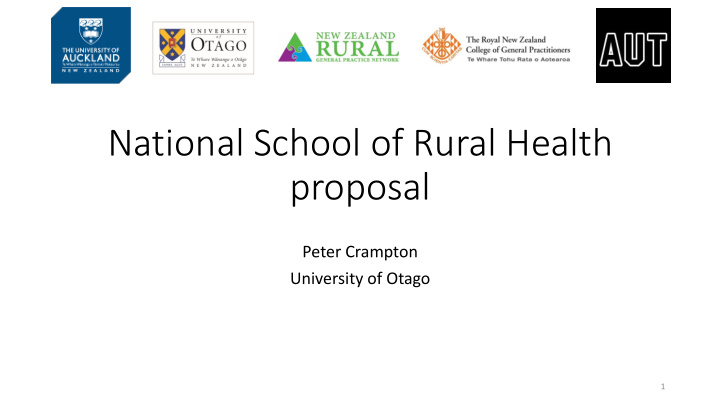



National School of Rural Health proposal Peter Crampton University of Otago 1
Outline • The problem • The proposed solution – National School of Rural Health • Overview of costs • Benefits • Next steps • Caveats and acknowledgements 2
Independent Urban Areas: 80% rely on rural health services 340,000 New Zealanders 3
The solution – National School of Rural Health • National solution • Collaborative • Builds on existing network of regional and rural solutions 4
The solution – National School of Rural Health • National solution • Collaborative • Builds on existing network of regional and rural solutions • Rurally based hubs • Partnerships with rural communities 5
University of Otago health sciences student placements 6
7
The solution – National School of Rural Health • National solution • Collaborative • Builds on existing network of regional and rural solutions • Rurally based hubs • Partnerships with rural communities • Hub and spoke model 8
The proposed Hub & Spoke Model Dr Garry Nixon 9
The solution – National School of Rural Health • National solution • Collaborative • Builds on existing network of regional and rural solutions • Rurally based hubs • Partnerships with rural communities • Hub and spoke model • Scalable 10
The solution – National School of Rural Health • National solution • Collaborative • Builds on existing network of regional and rural solutions • Rurally based hubs • Partnerships with rural communities • Hub and spoke model • Scalable • Interprofessional education (IPE) 11
Students learn with, from and about each other – in the treatment room, on a home visit, in the pharmacy, in the consultation room 12
The solution – National School of Rural Health • National solution • Collaborative • Builds on existing network of regional and rural solutions • Rurally based hubs • Partnerships with rural communities • Hub and spoke model • Interprofessional education (IPE) • Generalist practice • Rurally based academic and teaching roles 13
14
Nature of f costs Hubs Student • Community engagement • Student travel to/from placement • Development & Continuity • Maori & Pacific Liasion • Student placement accommodation • Refugee & Migrant • Student Travel within the placement • Training Infrastructure & IT capacity • Regional placement coordination School (centre) • Pastoral support for students • Academic leadership & capacity • National Leadership & Coordination • Rural Health Programme Material • IT Network & Communication Spokes • Rural Health Research • Training Infrastructure & IT network • Rural Clinical Access & Supervision 15
Benefit its • Creates and encourages a pathway for rural/regional employment • Strengthens sustainable health delivery for rural/regional communities • Fosters partnership between regional and national providers • Links strategy between Education and Health • Can be implemented immediately • Has flexibility for best hub ‘fit’ and pace of expansion • Is scalable, with low financial risk and no large government capital investment • Maximises opportunities from existing resources and programmes 16
Next Steps • Confirm governance/operational groups and project structure • Consultation plan – health/education, PHOs, Māori, rural health consumers • Funding • Hubs & spokes o Confirm IPE numbers & education providers o Shortlist of initial hubs/spokes 17
Consultation so far “Nothing about us without us” 20 DHBs Regulatory HWNZ MOH Chief Workforce Authorities Health Workforce Advisors for Strategy Professional Taskforce Nursing Group College of RHĀNZ Membership Groups Pharmacy Nurses Rural Women’s Organisations Aotearoa NZ NZ 18
Acknowledgements and caveats “We want the School of Rural Health and its hubs now. It’s a national solution to a national problem.” Dalton Kelly, CEO, NZ Rural General Practice Network “The School of Rural Health provides leadership for our rural hubs which will develop the best models of health service provision for all of our communities .” Garry Nixon, Rural Hospital Specialist, Dunstan Hospital 19
Recommend
More recommend